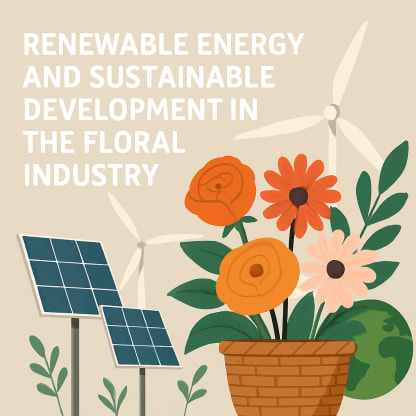Blooming Sustainably: Renewable Energy and the Future of the Flower Industry
The flower industry, often associated with beauty and celebration, has a hidden environmental cost. From energy-intensive greenhouses to international transportation, the sector leaves a significant carbon footprint. However, as the global focus on sustainability sharpens, the flower industry is beginning to explore how renewable energy and sustainable practices can reshape its future.
1. The Energy Challenge in Flower Production
Cut flowers are often grown in controlled environments that demand vast amounts of electricity and heat. Traditional energy sources not only drive up costs for growers but also contribute to greenhouse gas emissions. Transitioning to renewable energy sources like solar, wind, and geothermal can help reduce these impacts. Already, some farms in Europe and Africa are pioneering solar-powered irrigation systems and geothermal-heated greenhouses.
2. Sustainable Logistics and Transportation
A large percentage of flowers are transported across continents by air freight, which is carbon-intensive. The foreseeable future will likely see:
-
Expanded use of electric or hybrid ground transportation for regional distribution.
-
Investments in local flower farming to reduce reliance on imports.
-
Improved cold-chain logistics powered by renewable energy to minimize waste.
3. Circular Practices in Floriculture
Sustainable development in the flower industry also involves reducing waste and rethinking resource use:
-
Composting unsold flowers and organic waste to produce natural fertilizers.
-
Transitioning to biodegradable packaging instead of plastics.
-
Developing water recycling systems within greenhouses to address resource scarcity.
4. Technology and Innovation as Growth Drivers
Emerging technologies will play a vital role in making the flower industry more sustainable:
-
AI-powered smart greenhouses to optimize energy use.
-
Blockchain for supply chain transparency, ensuring ethical and eco-friendly practices.
-
LED lighting systems with renewable power integration to cut down on electricity consumption.
5. The Market Shift Toward Conscious Consumers
Consumers are increasingly demanding eco-friendly and ethically sourced flowers. Certification programs, such as Fairtrade and sustainability labels, are expected to expand and become key differentiators. In the foreseeable future, growers that embrace renewable energy and sustainability may not only reduce costs but also gain a competitive edge in the global marketplace.
Conclusion
The flower industry stands at a crossroads. By harnessing renewable energy and embedding sustainability at every stage of production and distribution, it can transform itself into a blooming example of green innovation. As consumers and businesses push for climate-conscious choices, the petals of tomorrow’s bouquets may carry with them not only beauty but also a promise of a more sustainable world.

